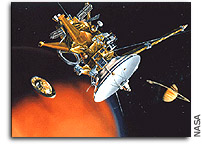Cassini Significant Events for 02/13/03 – 02/19/03

The most recent spacecraft telemetry was acquired from the Madrid
tracking station on Wednesday, February 19. The Cassini spacecraft is in
an excellent state of health and is operating normally. Information on
the present position and speed of the Cassini spacecraft may be found on
the “Present Position” web page located at
http://saturn.jpl.nasa.gov/operations/present-position.cfm .
On-board activities this week included completion of the Command &
Data Subsystem (CDS) flight software Assisted Load Format (ALF)
procedure to uplink ALFs to the Solid State Recorder (SSR). Once in
place the backup Attitude Control Subsystem (ACS) Flight Computer (AFC)
was loaded with new version A8 flight software, and the AFC was swapped
to place A8 onto the prime AFC. Then the new backup AFC was loaded with
A7 flight software off of the SSR. Additional activities included an
update of Trickle Telemetry on the backup AFC, an A8 Flight Software
parameter Memory Readout, checkout of the new ACS Telemetry Schedules,
an ACS Reaction Control Subsystem checkout, and clearing of the high
water marks on both the prime and backup AFCs.
The port 2 merge for C37 has been completed. All SEQGEN products have
been posted to the Distributed Object Manager, and an updated time
ordered listing, data volume report, and DSN allocation files are on the
C37 web site.
All but 3 data files from a collection of ~500 acquired during GWE #2
have been locally archived. Inquires are underway to determine if the
missing files are recoverable. The greatly increased speed and
efficiency in completion of this task as compared to data acquisition
and archiving for GWE1 and the Solar Conjunction Experiment is due to
improved data query software installed on the RSS Operations machines
prior to GWE2.
The Radio Science Systems Group has launched a redesigned website at
http://www.radioscience.jpl.nasa.gov/ . The site includes recent news
stories relating to radio-science, as well as technical documentation,
staff information, mission contributions, and science goals of
radio-science.
The Radio Science Subsystem (RSS) team made an initial delivery of
archived Gravitational Wave Experiment (GWE) #1 data to the Planetary
Data System (PDS) node for radio science (RS) data. The PDS advisor for
RS data has made suggestions on how to enhance the quality of the
archived data. This delivery by RSS not only fulfills a commitment to
deliver the data within one year of the end of the experiment, but it
also provides a pathfinder experience for the Cassini project on the
process for preparing and delivering archived data. A Visual and
Infrared Mapping Spectrometer science team meeting was held this week in
Tucson, Arizona.
The Spacecraft Operations Office (SCO) has upgraded the Cassini
Operational Reference Encyclopedia (CORE) software to Version 3.1. V 3.1
contains the revised command definitions for the new Attitude Control
and Command and Data Subsystem flight software. Installation on the
Cassini Web server by Mission Support and Services Office personnel is
now complete.
SCO delivered version 8.2 of the Kinematic Predictor/Inertial Vector
Propagator tool set. This version contains enhanced flight rule checking
and the new algorithms which will support the “Star Identification
Suspend” activity to be used during orbital operations.
Science Opportunity Analyzer (SOA) version 3.0 has been delivered to
Cassini. This version of SOA will be released in March with the MSS D8
adaptation for PC and Linux, and then again in MSS D9.1 with the latest
adaptation for Solaris 7, PC and Linux.
Composite InfraRed Spectrometer flight software version 2.0 was reviewed
at a Software Requirements Certification Review meeting, and approved
for testing in SCO before uplink to the spacecraft on May 19.
Uplink Operations personnel provided a Cassini Information Management
System (CIMS) introductory user training class to members of the Science
Planning team, Mission Support and Services Office (MSSO), and SCO.
This class is part of ongoing training provided to new Cassini flight
team members.
A special demonstration was given of the new prime/rider notification
features in CIMS. Principal Investigators, Co-Investigators, Team Leads,
Team members, Interdisciplinary Scientists, and others who participate
in the Target Working Team and Orbiter Science Team integration effort
benefited from learning how to use this science-team-requested
capability.
MSSO personnel hosted an Infrastructure Status Review. Some of the
topics addressed included current infrastructure and support, planned
implementation of project budget guidelines, changes in network
infrastructure, upgrades to sustain existing workstations, and upcoming
changes to maintenance and support.
Outreach reported that the Cassini web development team has launched an
“Image of the Week” campaign. Each week a new image will highlight a
different aspect of Cassini’s journey to Saturn. Images will rotate
between categories as diverse as mission highlights, historical photos,
mission and spacecraft technology, and outreach activities. Check out
the latest image on the main web site ( http://saturn.jpl.nasa.gov/ ).
Cassini is a cooperative project of NASA, the European Space Agency and
the Italian Space Agency. The Jet Propulsion Laboratory, a division of
the California Institute of Technology in Pasadena, Calif., manages the
Cassini mission for NASA’s Office of Space Science, Washington, D.C.








